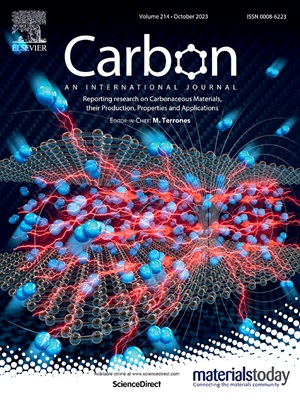迈向更清洁的室内空气:分析分子化学和空间约束对甲醛及其衍生物在功能化石墨烯表面化学吸附的影响
IF 11.6
2区 材料科学
Q1 CHEMISTRY, PHYSICAL
引用次数: 0
摘要
从理论上研究了选定的挥发性有机化合物甲醛、丙烯醛、乙醛和丙酮与功能化石墨烯表面的相互作用。重点研究了化学吸附过程中含氧和含氮基团对能垒的影响。由于分散型相互作用增强,丙烯醛和丙酮在物理吸附过程中表现出最高的稳定能。发现酚OH基团最容易与目标化合物的羰基氧相互作用,导致随后的共价键形成。所考虑的所有分子的化学吸附能垒均低于10千卡摩尔−1,表明它们在室温下很容易从气相中发生化学吸附。同时,所有分子的解吸能垒均大于20 kcal mol−1,表明在室温下解吸是不可能的。发现nh型部分不太有利,尽管它们的存在经常导致化学吸附。发现化学吸附的效率取决于空间约束和羰基碳原子上的电荷。甲醛衍生物的吸电子部分对成键效率有负面影响。这些理论发现得到了实验结果的支持。本文章由计算机程序翻译,如有差异,请以英文原文为准。

Towards cleaner indoor air: Analyzing the effects of molecule chemistry and steric constraints on the chemisorption of formaldehyde and its derivatives on functionalized graphene surfaces
Interactions of selected volatile organic compounds namely formaldehyde, acrolein, acetaldehyde, and acetone with functionalized graphene surfaces were theoretically investigated. The focus was on the effects of oxygen and nitrogen containing groups on the energy barriers during the chemisorption processes. Acrolein and acetone exhibit the highest stabilization energies during the physisorption due to enhanced dispersion-type interactions. The phenolic OH groups were found as the most prone to interact with carbonyl oxygen of the target compounds resulting in the subsequent covalent bond formation. The energy barriers for the chemisorption are lower than 10 kcal mol−1 for all molecules considered, indicating that their chemisorption from the vapor-phase readily occurs at room temperature. Simultaneously, the energy barriers for the desorption are above 20 kcal mol−1 for all molecules, indicating that desorption at room temperature is not possible. NH-type moieties were found to be less advantageous although their presence frequently leads to chemisorption. The efficiency of the chemisorption was found to be dependent on steric constraints and on the charge on the carbonyl carbon atom. The electron withdrawing moieties of formaldehyde derivatives were found as negatively affecting a bond formation efficiency. The theoretical findings were supported by those found in experimental approaches.
求助全文
通过发布文献求助,成功后即可免费获取论文全文。
去求助
来源期刊

Carbon
工程技术-材料科学:综合
CiteScore
20.80
自引率
7.30%
发文量
0
审稿时长
23 days
期刊介绍:
The journal Carbon is an international multidisciplinary forum for communicating scientific advances in the field of carbon materials. It reports new findings related to the formation, structure, properties, behaviors, and technological applications of carbons. Carbons are a broad class of ordered or disordered solid phases composed primarily of elemental carbon, including but not limited to carbon black, carbon fibers and filaments, carbon nanotubes, diamond and diamond-like carbon, fullerenes, glassy carbon, graphite, graphene, graphene-oxide, porous carbons, pyrolytic carbon, and other sp2 and non-sp2 hybridized carbon systems. Carbon is the companion title to the open access journal Carbon Trends. Relevant application areas for carbon materials include biology and medicine, catalysis, electronic, optoelectronic, spintronic, high-frequency, and photonic devices, energy storage and conversion systems, environmental applications and water treatment, smart materials and systems, and structural and thermal applications.
 求助内容:
求助内容: 应助结果提醒方式:
应助结果提醒方式:


